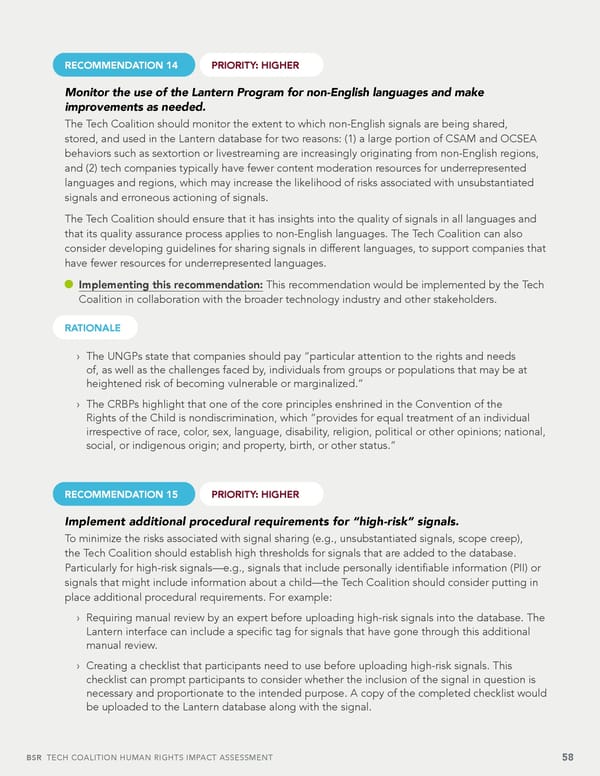RECOMMENDATION 14 PRIORITY: HIGHER Monitor the use of the Lantern Program for non-English languages and make improvements as needed. The Tech Coalition should monitor the extent to which non-English signals are being shared, stored, and used in the Lantern database for two reasons: (1) a large portion of CSAM and OCSEA behaviors such as sextortion or livestreaming are increasingly originating from non-English regions, and (2) tech companies typically have fewer content moderation resources for underrepresented languages and regions, which may increase the likelihood of risks associated with unsubstantiated signals and erroneous actioning of signals. The Tech Coalition should ensure that it has insights into the quality of signals in all languages and that its quality assurance process applies to non-English languages. The Tech Coalition can also consider developing guidelines for sharing signals in different languages, to support companies that have fewer resources for underrepresented languages. Implementing this recommendation: This recommendation would be implemented by the Tech Coalition in collaboration with the broader technology industry and other stakeholders. RATIONALE › The UNGPs state that companies should pay “particular attention to the rights and needs of, as well as the challenges faced by, individuals from groups or populations that may be at heightened risk of becoming vulnerable or marginalized.” › The CRBPs highlight that one of the core principles enshrined in the Convention of the Rights of the Child is nondiscrimination, which “provides for equal treatment of an individual irrespective of race, color, sex, language, disability, religion, political or other opinions; national, social, or indigenous origin; and property, birth, or other status.” RECOMMENDATION 15 PRIORITY: HIGHER Implement additional procedural requirements for “high-risk” signals. To minimize the risks associated with signal sharing (e.g., unsubstantiated signals, scope creep), the Tech Coalition should establish high thresholds for signals that are added to the database. Particularly for high-risk signals—e.g., signals that include personally identi昀椀able information (PII) or signals that might include information about a child —the Tech Coalition should consider putting in place additional procedural requirements. For example: › Requiring manual review by an expert before uploading high-risk signals into the database. The Lantern interface can include a speci昀椀c tag for signals that have gone through this additional manual review. › Creating a checklist that participants need to use before uploading high-risk signals. This checklist can prompt participants to consider whether the inclusion of the signal in question is necessary and proportionate to the intended purpose. A copy of the completed checklist would be uploaded to the Lantern database along with the signal. BSR TECH COALITION HUMAN RIGHTS IMPACT ASSESSMENT 58
 Tech Coalition Human Rights Impact Assessment of the Lantern Program Page 57 Page 59
Tech Coalition Human Rights Impact Assessment of the Lantern Program Page 57 Page 59